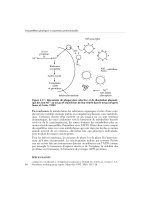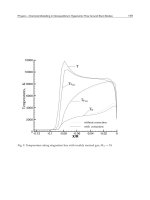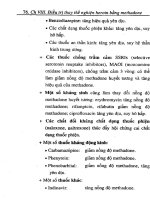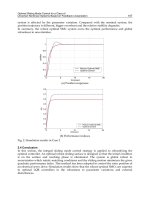Antiviral agents vaccines and immunotherapies - part 5 doc
Bạn đang xem bản rút gọn của tài liệu. Xem và tải ngay bản đầy đủ của tài liệu tại đây (1.24 MB, 44 trang )
General (Non-antiretroviral) Antiviral Drugs 163
Table 3.8 Clinical Studies and Published Reports that Support
the Use of Famciclovir
Topic Findings Reference
Dosage for off-label
treatment for
herpes labialis
Genital herpes regimen dosing is
not sufficient for treatment of
herpes labialis. Use of higher
doses may be necessary to
reduce lesion healing time
(e.g., 500 mg TID for 5 days).
157
Efficacy in reducing
number of
recurrences of
genital herpes
Famciclovir delays the time of the
first recurrence of genital
herpes. The number of patients
remaining lesion free was 3
times higher in famciclovir than
in placebo recipients.
158,159
Comparison of
famciclovir with
acyclovir for
treatment of HSV in
HIV-positive
patients
Both acyclovir and famciclovir are
well tolerated, generally safe to
use, and effective
160
Symptomatic and
asymptomatic viral
shedding in women
For those women with a history
of recurrent genital herpes,
famciclovir reduces the
frequency and delays the
onset of viral shedding.
161
Genital herpes
recurrences
Famciclovir is effective in
increasing the time to
first recurrence of genital
herpes and increasing the
number of recurrence-free
patients.
159,160
Suppression of HSV
reactivation in HIV-
positive patients
Famciclovir treatment of 500 mg
twice daily for 8 weeks
significantly reduces symptoms
and viral shedding.
161
Herpes zoster in
immunocompetent
patients; reduction
of postherpetic
neuralgia
Famciclovir is effective at reducing
PHN when used 500 mg t.i.d. for
7 days, especially among persons
50 years of age and older.
162,163
(continued)
164 Antiviral Agents
Treatment
Dosages for treatment vary according to the disease treated,
the severity of an outbreak, and the recurrence rate of out-
breaks as shown in Table 3.9.
Adverse Events
Headache.
Nausea.
Diarrhea.
Increased serum concentrations of penciclovir. Serum
concentrations of penciclovir may occur if famciclovir is
Table 3.8 (Continued)
Topic Findings Reference
Rapid resolution of
zoster-associated
pain
Famciclovir is as effective and
more convenient than acyclovir
for rapid resolution of zoster-
associated pain.
163,164
Ophthalmic zoster Famciclovir 500 mg 3 times daily
was well tolerated and
demonstrated efficacy similar to
acyclovir 800 mg 5 times daily
153
Ramsey Hunt
syndrome
A 7–10 day course of famciclovir
(500 mg 3 times daily) combined
with 3–5 days of oral prednisone
(60 mg/day) is effective against
VZV-mediated Ramsey Hunt
syndrome.
112,165
Treatment of herpes
zoster in
immunosuppressed
patients
Famciclovir is safe and effective. 166
Hepatitis B virus
(HBV)
Only limited in vivo effect on HBV. 167–169
HBV disease in liver
transplant
recipients and
recurrent HBV
disease
Famciclovir administered
independently seems to be of
limited efficacy in the treatment
of HBV after liver
transplantation.
170
General (Non-antiretroviral) Antiviral Drugs 165
used concurrently with probenecid (or other drugs signif-
icantly eliminated by active renal tubular secretion).
Special Considerations
Renal impairment. For patients with renal impair-
ment, all regimens in Table 3.9 will require dosage ad-
justments.
Coadministration with probenecid or other relat-
ed drugs. Administration of drugs eliminated by ac-
tive renal tubular secretion with famciclovir may cause
increased serum concentrations of penciclovir.
Drug resistance. For hepatitis B, five domains (labeled
A–E) have been identified. Domains B and E may affect
primary and template positioning. Structural changes
in these domains may affect oral resistance to nucleo-
side analogues. Famciclovir promotes mutations in the
B domain. A mutation at position 528 (Leu replaced by
Table 3.9 Treatment Table for Famciclovir
Symptom Treatment
Herpes zoster initiation Famciclovir 500 mg every 8 hours for
7 days, begun at the earliest signs of
the disease.
Chickenpox in adolescents
and adults
Famciclovir 500 mg every 8 hours for
7 days.
Episodic treatment of genital
herpes
Famciclovir 125 mg twice daily for
5 days.
Chronic suppressive
treatment of recurrent
genital herpes
Famciclovir 250 mg twice daily for
1–2 years, followed by a reevaluation
of patient’s recurrences.
Recurrent orolabial or
genital herpes in HIV-
positive patients.
Famciclovir 500 mg twice daily for
7 days.
Initial outbreak of HSV in
HIV-positive patients
250–750 mg t.i.d. for 5–10 days
Recurrent anogenital herpes
in HIV-positive patients
with CD4
+
counts of <200 ×
10
6
cells/ml
500 mg twice daily for 7 days is as
effective as acyclovir 400 mg 5 times
daily for 7 days.
166 Antiviral Agents
Met or Val) also occurs during lamivudine therapy and
may cause cross-resistance. A summary of susceptible
positions for the B-domain resistance for famciclovir is
shown in Table 3.10.
Approval. Famciclovir has been approved for the episodic
therapy and for chronic suppression of recurring HSV
as well as treatment of herpes zoster in North America
and in some, but not all, European countries (137).
Penciclovir
Introduction
Penciclovir is acyclic nucleoside analogue which has in vitro
activity against HSV-1, HSV-2, and VZV (175) (Fig. 3.12). FDA
approval is only for topical treatment of recurrent herpes labi-
alis as the oral bioavailability is extremely low. Intravenous
penciclovir shows promise for the treatment of mucocutaneous
herpes simplex infections in those with immunosuppression.
Table 3.10 Nucleotide changes that induce resistance
to famciclovir in genotype A hepatitis B virus
V521L
P525L
L528M
L528V
T532S
Fig. 3.12 Associated names, structure, and applicability of
penciclovir.
General (Non-antiretroviral) Antiviral Drugs 167
The active form of penciclovir is significantly more stable in
HSV-infected cells (in vitro half-life of 10–20 hours) when com-
pared to acyclovir (0.7 to 1 hour) (174).
Mechanisms of Action
Like acyclovir, penciclovir must be phosphorylated by viral
thymidine kinase and cellular kinases prior to its competitive
inhibition of viral DNA polymerase (Fig 3.13). However, pen-
ciclovir is not an obligate DNA-chain terminator like acyclovir
(175,176).
Clinical Studies to Support the Use of Penciclovir
There is only one major study involving immunocompetent
patients that demonstrates that penciclovir treatment results
in improvement in a variety of facets. These improvements
were observed at all stages of a herpes labialis outbreak: pro-
drome, erythema, papule, and vesicle. Table 3.11 (151) high-
lights the parameters measured and analyzed.
Treatment
Herpes labialis lesions may be treated with topical cream
(Table 3.12). Treatment should be initiated as early as possi-
ble during the course of an outbreak. The systemic uptake of
penciclovir is negligible.
Adverse Events
Adverse events are similar to those of acyclovir and valacyclovir.
Table 3.11 Efficacy of Penciclovir in Treating Herpes Labialis
Topic Findings Reference
In immunocompetent patients:
a. Healing time
b. Pain duration
c. Viral shedding
Topical 1% penciclovir
decreases:
Average healing time
by 0.7 days
Average duration of
pain by 0.6 days
Significantly
shortened.
151
168 Antiviral Agents
Fig. 3.13 Phosphorylation of penciclovir to inactivate viral DNA polymerase.
General (Non-antiretroviral) Antiviral Drugs 169
Ganciclovir
Introduction
Ganciclovir, a nucleoside analogue, is used to prevent and treat
the manifestations of CMV in immunocompromised patients
(177–179). This is important as CMV infection in immunocom-
petent individuals tends to be brief and self-limited. However,
CMV can be severe and life-threatening in neonates, transplant
recipients, and HIV-positive patients. Oral ganciclovir is avail-
able for CMV prophylaxis, but it is not considered to be as effec-
tive as other means. Valganciclovir a prodrug of ganciclovir, has
improved bioavailability. Ganciclovir may also have in vitro effi-
cacy against EBV (HHV-4) replication (Fig. 3.14).
Mechanism of Action
The viral-encoded phosphotransferase (thymidine kinase)
monophosphorylates ganciclovir, a nucleoside analogue, to the
active triphosphate form. This triphosphate form becomes
part of a newly synthesized DNA chain. This inhibits further
Table 3.12 Treatment of Viral Diseases with Penciclovir
Symptom Treatment
Herpes labialis lesions
(immunocompetent
patients)
Apply topical 1% penciclovir cream to
herpes labialis lesions every 2 hours
while awake for 4 days to reduce healing
time, pain duration, and viral shedding.
Fig. 3.14 Associated names, structure, and applicability of
ganciclovir.
170 Antiviral Agents
DNA synthesis by inhibiting DNA polymerase and by induc-
ing premature chain termination (180–183) (Fig. 3.15). The
thymidine kinase (TK) encoded by HSV or VZV has a broad
substrate specificity that permits interaction by acyclovir or
ganciclovir. Phosphorylation of ganciclovir in CMV-infected
cells is dependent upon a protein kinase. The role of the kinase
is not completely understood and is under study. In HHV-6, a
similar mechanism activates ganciclovir. Mutations for drug
resistance most often occur in the UL97 gene that affects the
monophosphorylation process or the UL54 gene that codes for
DNA polymerase in human CMV (184). Graft-versus-host-
disease can be prevented when donor T cells are transfected to
express herpes simplex virus thymine kinase. Cells that express
this enzyme are susceptible to ganciclovir, which opens a new
avenue for addressing drug resistance.
Clinical Studies and Reports that Support the Use of
Ganciclovir
Oral ganciclovir is available for CMV prophylaxis, but is not
as effective as intravenous treatment. Valganciclovir has bet-
ter availability (177,178,183,185–193) (Table 3.13).
Treatment
Intravenous ganciclovir is the drug of choice for treatment of
CMV in transplant recipients or AIDS patients (194) (Table 3.14).
The ocular implant of ganciclovir for treatment of CMV retini-
tis provides a better clinical outcome for disease regression and
the convenience of ambulatory therapy. This, however, must be
balanced against the potential of intra-ocular side effects or
contralateral eye infection by CMV (185). Late-onset cytomeg-
alovirus disease among organ transplant recipients is common
and the current thought is that antiviral prophylaxis, such as
with ganciclovir, be used preemptively. Allograft rejection is
often associated with CMV risk. Those patients on ganciclovir
may benefit from extended and/or enhanced antiviral prophy-
laxis (195). Stem cell transplantation (SCT) has similar chal-
lenges in that SCTs are at increased risk of developing CMV
pneumonia where the best available therapy has a mortality
General (Non-antiretroviral) Antiviral Drugs 171
Fig. 3.15 Phosphorylation of ganciclovir to inactivate viral DNA polymerase.
172 Antiviral Agents
Table 3.13 Clinical Studies and Reports of Ganciclovir Usage
Topic Findings Reference
Bioavailability Oral bioavailability is 8–9%.
Needs to be administered by
daily intravenous infection.
183
Treatment and
prevention of CMV in
immunocompromised
patients
Ganciclovir is usually
administered intravenously
because of poor oral
bioavailability.
177,178,
183
CMV retinitis The ocular implant may be used
to treat CMV, although it
requires surgical insertion
every six months.
185
Foscarnet vs ganciclovir Ganciclovir is preferred due to
less severe side effects.
186
Ganciclovir vs
valganciclovir
Valganciclovir has better oral
bioavailability and fewer
severe side effects.
EBV-positive tumor in the
positive
immunocompetent
(Phase I/II trial)
Induce latent viral TK gene and
enzyme in tumor cells using
arginine butyrate, followed by
ganciclovir treatment in
standard treatment doses.
187
HHV-6 HHV-6 reactivation in
transplant patients is
controlled with ganciclovir.
188
CMV with acute
lymphoblastic leukemia
Ganciclovir can be used to
manage CMV infection.
189
Cytotoxicity in retinas
(in vitro)
Ganciclovir shows no toxicity in
micromolar concentration.
190
CMV after solid organ
transplantation
Ganciclovir is effective for
kidney, liver, heart, and lung
transplant recipients as
preemptive therapy.
191
Globulin plus ganciclovir
to treat CMV in a solid
organ transplant
patient
Oral ganciclovir given
preemptively reduces
invasion of tissue by CMV-
associated disease.
192
CMV retinitis intravitreal
vs intravenous therapy
Induction therapy should be
prolonged until complete
inactivation of CMV retinitis
is obtained before beginning
maintenance therapy.
193
General (Non-antiretroviral) Antiviral Drugs 173
rate of 45–78%; therefore, post-operative prevention of CMV is
critical (196).
Adverse Effects
Dosage of ganciclovir must often be limited due to:
Bone marrow suppression. Bone marrow suppression
may also be accompanied by thrombocytopenia, neu-
tropenia, anemia, and granulocytopenia.
Retinal toxicity. High doses of intravitreal ganciclovir
may cause retinal damage (197).
Also involved may be:
Renal insufficiently.
Neutropenia.
Fever.
Rash.
Headache.
Irritation and phlebitis. Irritation and phlebitis may
occur at the infusion site.
Nausea. May occur with arginine butyrate combined
with ganciclovir to treat Epstein-Barr tumors.
Ganciclovir resistance. A recent study demonstrated
that 26 of 210 patients with CMV retinitis expressed
phenotypic or genotypic ganciclovir-resistance (198).
Special Considerations
Animal studies. Ganciclovir was found to be teratoge-
nic, carcinogenic, and mutagenic in animal studies. It
also caused aspermatogenesis.
Combination therapy with foscarnet. In cases of fail-
ure of monotherapy, ganciclovir can be combined with
foscarnet for treatment.
Table 3.14 Treatment with Ganciclovir
Symptom Treatment
Failed monotherapy for CMV retinitis Combine foscarnet and
ganciclovir.
CMV retinitis Ocular implants.
174 Antiviral Agents
Monitoring of CMV infection in immunocompro-
mised transplant patients. The results of quantitative
antigenemia, which uses buffy coat cell preparations,
may differ significantly from quantitative PCR, which
uses plasma for the analysis of ganciclovir resistance.
Once ganciclovir is initially introduced for treatment of
CMV, quantitative PCR levels drop. A subsequent use of
both quantitative PCR and antigenemia may be indica-
tive of the emergence of ganciclovir-resistant CMV. Once
foscarnet is administered, both the PCR and antigene-
mia levels drop. The results of the quantitative PCR can
often be used to provide pre-emptive treatment before
traditional clinical indicators appear (199). PCR with
plasma performed best in a comparison with seven other
laboratory assays. This permitted pre-emptive treat-
ment with ganciclovir (200).
Arginine butyrate/ganciclovir treatment of EB
tumors. Arginine butyrate/ganciclovir treatment does
not appear to activate HIV transcription rates (187).
Pregnant women. Only limited studies have been done,
but no large-scale safety data exists (201).
Neonates and pediatric patients. Ganciclovir has
been used effectively in pediatric transplant patients,
but safety of use in neonates with CMV infection has
not been established (202).
Effect of corticosteroids on efficacy. In transplant pa-
tients, corticosteriod use may promote early pp65 anti-
genemia rather than emergence of a ganciclovir-resistant
virus. Therefore, an immediate switch from ganciclovir
to foscarnet (with more severe side effects) may not be
warranted. Instead, dose intensification with ganciclovir
should continue to be the medication of choice (203,204).
Valganciclovir
Introduction
Valganciclovir is used to treat CMV retinitis, an infection in
eyes of immunocompromised patients. Valganciclovir does not
cure CMV, but it can keep symptoms from becoming worse or
General (Non-antiretroviral) Antiviral Drugs 175
cause some improvement. Oral valganciclovir has increased
availability when compared with oral ganciclovir. As with all
other antivirals, valganciclovir-resistant strains are emerging
(205) (Fig. 3.16).
Mechanism of Action
Valganciclovir is a valylester prodrug of ganciclovir with
approximately 10 times the bioavailability of oral ganciclovir
(Fig. 3.17).
Clinical Findings and Reports That Support the Use of
Valganciclovir
Valganciclovir has been used to treat CMV retinitis (205)
(Table 3.15).
Treatment
Oral tablets are available in the United States. Adults should
take 900 mg two times a day with food (Table 3.16).
Adverse Effects
Anemia and other blood problems. Valganciclovir can
suppress the numbers of white blood cells, increasing
the opportunity for infection. Valganciclovir also low-
ers blood platelet number which may increase blood
clotting time.
Fig. 3.16 Associated names, structure, and applicability of
valganciclovir.
176 Antiviral Agents
Fig. 3.17 Phosphorylation of valganciclovir to inactivate viral DNA polymerase.
General (Non-antiretroviral) Antiviral Drugs 177
Gastrointestinal. Presence of blood in urine or stools,
with stools possibly appearing black or tarry, and pain-
ful or difficult urination are common side effects of val-
ganciclovir. Abdominal pain, diarrhea, nausea, and
vomiting are normally less serious side effects.
Respiratory distress or infection. Cough, hoarseness,
troubled breathing, nasal congestion, sore throat,
chills, fever, lower back or side pain, unusual bleeding,
bruising, or fatigue could be seen if a patient is taking
valganciclovir.
Mucocutaneous. Ulcers, sores or white spots may ap-
pear in the mouth, paler than usual appearance of the
skin, pinpoint red macules on skin, or allergic (hive-
like) swelling or itching are indicators of adverse ef-
fects of valganciclovir.
Ophthalmological. Seeing flashes of light, floating
spots before the eyes, or a “veiled curtain” appearing
across the field of vision can be indicators of side effects
of valganciclovir.
Neurological. Rare but serious side effects may be con-
fusion, illogical thinking, seizures, or false sensations.
Agitation may also occur.
Table 3.15 Published Reports of Valganciclovir Usage
Topic Findings Reference
CMV retinitis
Effect of valganciclovir
or ganciclovir
resistance on CMV
retinitis
Mutations increased with drug
exposure over time.
Retinitis progression, however,
could not be linked to UL97
genotype mutation.
205
Table 3.16 Treatment with Valganciclovir
Symptom Treatment
CMV prophylaxis 900 mg b.i.d. with food.
178 Antiviral Agents
Special Considerations
Concomitant therapy. Taking valganciclovir with
didanosine, mycophenolate, or probenecid may increase
the chance of side effects.
Pregnant and breast-feeding women. Valganciclovir
has not been studied in pregnant women but animal
studies indicate that valganciclovir causes birth de-
fects and other problems. Men who are taking valgan-
ciclovir should use a condom to avoid impregnating
their spouse, not only during the course of treatment
but for at least 90 days following treatment. Use of
valganciclovir during pregnancy should be avoided
whenever possible.
Studies to determine the transfer of valganciclovir
from nursing mothers to their infants have not been
completed. Valganciclovir is not recommended during
breast-feeding because it may cause unwanted effects
in nursing babies.
Pediatric use. No studies have been done on pediatric
patients.
Elderly. No studies have been done on elderly patients
and it is not known if valganciclovir causes different
side effects or problems in older people.
Kidney disease. Valganciclovir increases the chances of
side effects as it accumulates in the blood in patients
with kidney disease.
Blood diseases. Low platelet count, low red blood cell
count, or low white blood cell count may be exacerbated
by valganciclovir.
Ribavirin
Introduction
Severe viral pneumonia—respiratory syncytial virus RSV—in
children can be effectively treated by ribavirin. Ribavirin is a
broad-spectrum antiviral nucleoside. In addition to being used
to treat RSV pneumonia, it is also used to treat strains of influ-
enza A and B and Lassa fever, off-label. It is emerging as a
General (Non-antiretroviral) Antiviral Drugs 179
possible treatment for adenovirus (206). As summarized by
Gavin and Katz, adenovirus sites are found throughout the
body as cystitis, pneumonia, enteritis, colitis, hepatitis, nephri-
tis, etc., and survival-rate improvements are high enough to
consider IV ribavirin a feasible treatment modality (206). Many
other viruses respond to ribavirin, including hepatitis A, B,
and C, particularly when combined with pegylated interferon-
alpha (for more information, refer to ribavirin-PEG-interferon,
page 213). Ribavirin is a white crystalline powder with high
solubility in water and limited solubility in anhydrous alcohol.
Figure 3.18 shows the structure of ribivarin.
Mechanisms of Action
Ribavirin, a broad-spectrum antiviral nucleoside (guanosine)
analog, phosphorylates easily. Although the mechanisms of
ribavirin remain unclear (207), ribavirin appears to be a non-
specific antiviral with most of its efficacy due to incorporation
of the ribavirin into the viral genome. Ribavirin undergoes
dehydration synthesis to form new products (Fig. 3.19). When
cells are exposed to ribavirin, there is a reduction in intracel-
lular guanosine triphosphate—a requirement for translation,
transcription, and replication in viruses and a reason for the
broad-spectrum attributes of ribavirin (208). Ribavirin signif-
icantly increases the mutation rate of RNA in poliovirus and
Fig. 3.18 Associated names, structure, and applicability of
ribavirin.
180 Antiviral Agents
reduces viral fitness (Fig. 3.20). Thus, an understanding of the
in-depth mechanisms of ribavirin activity could contribute to
the development of lethal mutagenesis as an effective antivi-
ral strategy.
Studies that Support Treatment with Ribavirin
Ribavirin may help treat orthopoxviruses, influenza and chronic
hepatitis A and B (206,209,210) (Table 3.17).
Treatment
Ribavirin is usually prescribed as an inhalant for infants and
small children. Elderly patients, teenagers, and adults are
usually not prescribed ribavirin. Ribavirin is readily absorbed
with oral administration and there is a linear relationship
between the time of last administration and the dosage.
Although the tablets are taken with food, there is insufficient
data to determine the effect of different types of diets (high fat,
high protein, vegetarian, etc.) on ribavirin absorption. Dos-
ages and types of administration are shown in Table 3.18.
Adverse Effects
Unusual tiredness and weakness. May occur in pa-
tients taking ribavirin by mouth or injection for Lassa
fever.
Headache. Occurs rarely.
Itching, redness, and swelling of the eyes. Occurs
rarely.
Skin rashes. Occurs rarely.
Fig. 3.19 Ribavirin bonding to cytosine and uracil.
General (Non-antiretroviral) Antiviral Drugs 181
Fig. 3.20 Mechanisms of action of ribavirin. Ribavirin is a nucleoside analog that readily
phosphorylates to ribavirin triphosphate. Ribavirin is incorporated into the viral genome by
binding to cytosine and uracil.
182 Antiviral Agents
Table 3.17 Studies that Support the Use of Ribavirin
Topic Finding Reference
Severe adenovirus disease in
immunocompromised
children
Two of five children
recovered, whereas
non-treatment would
have resulted in five
non-recoveries. Early
intervention (diagnosis
via PCR) with ribavirin
may make earlier, more
effective treatment
possible
206
Orthopoxviruses (in vivo) Ribavirin has an
inhibitory activity
against orthopox
viruses.
209
Lassa fever Ribavirin given orally or
by injection.
210
Influenza A and B Ribavirin given by aerosol
inhalation.
210
Table 3.18 Treatment Modalities for Ribavirin
Symptoms Treatment
Chronic hepatitis C Capsules: Must be combined with
Interferon –alpha therapy to be effective.
(See Table 3.28.)
Respiratory syncytial
virus (RSV)
Inhalation therapy: Dosage for treating
infants must be determined by
physicians. Dosage has not been
determined for adults and teenagers.
Usually not prescribed for the elderly.
Influenza A and B Given by aerosol inhalation as a fine mist
by using a nebulizer attached to an
oxygen hood, tent, or facemask.
Lassa fever Given either orally or by injection.
Adenoviruses Intravenous ribavirin can be used as a
compassionate-use medicine in severely
immunocompromised patients with
adenovirus.
General (Non-antiretroviral) Antiviral Drugs 183
Combination Therapy with Interferon-alpha. The
adverse events of this combination therapy are signif-
icant and include severe depression with suicidal ten-
dencies, hemolytic anemia, suppression of bone
marrow function, pulmonary dysfunction, pancreatitis,
and diabetes.
Special Considerations
Combination with Interferon-alpha. Combination
therapy of ribavirin with interferon alpha has been
shown to be effective in the treatment of hepatitis C.
Ribavirin monotherapy is not effective. However, there
may be severe adverse effects (see the preceding sec-
tion). For example, patients with autoimmune hepati-
tis become worse when treated with this therapy.
Allergies. Some patients are allergic to ribavirin. The
possibility exists that children who are allergic to food,
preservatives, dyes, or other substances may also be al-
lergic to ribavirin.
Pregnancy. Ribavirin for inhalation therapy for very
young children may cause exposure to women who are
pregnant (or may become pregnant) if they spend
time at the bedside when the inhalation therapy is
being administered. The effect of ribavirin on prena-
tal development has not been tested in humans, but
breast milk containing ribavirin has been shown to
cause birth defects and other problems in certain an-
imal studies.
Hepatic dysfunction. In patients with decreased he-
patic function, the pharmacokinetics of ribavirin can-
not be accurately predicted. Therefore, the dosage may
need to be increased for efficacy, but monitored careful-
ly to reduce adverse effects.
Breast milk. In animal studies, ribavirin passes to the
offspring through breast milk and can cause problems
in nursing animals and the young. There have been
no tests on humans.
184 Antiviral Agents
NUCLEOTIDE ANALOGS
The derivatives of nucleosides that are monophosphorylated
belong to the nucleotide analogs. Those with antiviral properties
include cidofovir, adefovir, and tenofovir. Tenofovir is used to
treat HIV infection and is discussed in Chapter 2, page 62.
Phosphorylation of nucleosides occurs within the cyto-
plasm of cells that are beginning mitotic division. The synthe-
sis of bases that contribute to DNA chain elongation is limited
by the inclusion of nucleotide analogs. Mitochondrial DNA-
polymerase may also be affected.
Cidofovir
Introduction
Cidofovir has received much attention as a therapy for many
viral diseases (Fig. 3.21). Although preemptive antiviral ther-
apy for CMV infection following allogenic stem cell transplan-
tation is recommended as an effective strategy for preventing
CMV disease, some studies do not support this hypothesis
(211). Cidofovir is considered an option for the treatment of
acyclovir-resistant HSV although it has not been FDA-
approved for this purpose. However, there is an increasing
need for additional therapies as more herpes viral strains
Fig. 3.21 Associated names, structure, and applicability of
cidofovir.
General (Non-antiretroviral) Antiviral Drugs 185
become acyclovir-resistant. Cidofovir shows promise as a ther-
apy against TK-deficient strains of HSV. As the first acyclic
phosphonate nucleotide approved for use in the United States,
cidofovir can be used to treat CMV retinitis inpatients with
AIDS. AIDS patients treated with cidofovir for CMV retinitis
often report an improvement in AIDS-related Kaposi’s sarcoma.
Cidofovir is the most effective anti-orthopoxvirus agent
currently under preclinical investigation (212). Other diseases
for which cidofovir is used include VZV, CMV, HPV, polyoma
viruses, adenoviruses, and other poxviruses (213). Cidofovir
shows efficiency against JC virus in vitro (214). Cidofovir is
considered to be the second-line therapy for CMV disease after
the first antiviral failed (215). Anogenital warts respond to
cidofovir topical gel (216).
Mechanism of Action
Cidofovir is considered to be an acyclic phosphonate nucle-
otide. Cidofovir is similar to foscarnet in that it does not require
thymidine kinase for phophorylation (Fig. 3.22). To become
activated, the drug is phosphorylated by cellular kinase to
cidofovir diphosphate (217–219), which makes it effective
against TK-deficient strains of HSV. HHV-8 replication is sen-
sitive to cidofovir. Although cidofovir is poorly absorbed by
mouth, aerosolized cidofovir may help create a barrier against
aerosolized virus infections. Cidofovir acts as a chain termina-
tor for viral DNA polymerase. After intracellular phosphoryla-
tion to a diphosphate form, activity occurs at the 3′ end of the
viral DNA with termination at the end of two sequences.
Clinical Studies and Reports that Support the Use of Cidofovir
Several studies document the treatment of acyclovir-resistant
and normal strains of HSV with topical cidofovir. Representa-
tive studies are highlighted in Table 3.19 (213,215,220–251).
The FDA did not approve the use of cidofovir gel for acyclovir-
resistant herpesvirus infection due to a lack of sufficient phase-
three data (229). However, the manufacturer has reported suc-
cessful treatment of HSV with compounded cidofovir cream
(230). Cidofovir delays the progression of CMV retinitis in
186 Antiviral Agents
Fig. 3.22 Phosphorylation of cidofovir to inactivate viral DNA polymerase.
General (Non-antiretroviral) Antiviral Drugs 187
Table 3.19 Studies and Reports of Cidofovir Usage
Topic Findings Reference
CMV retinitis in
AIDS patients
Intravenous cidofovir, given once
weekly for 2 weeks, followed by
maintenance therapy once every
2 weeks, delays the progression
of CMV retinitis in AIDS
patients.
220–224
HHV-8 Kaposi’s sarcoma in an HIV-
negative patient was
unresponsive to intralesional
cidofovir.
225–227
Kaposi’s sarcoma Cidofovir used to treat CMV
retinitis may also improve
Kaposi’s sarcoma.
HSV Cidofovir is effective in treating
acyclovir-resistant HSV.
228–230
HPV Treatment of CIN-III (cervical
intraepithelial neoplasia, grade
III), laryngeal, and cutaneous
papilloma lesions
213
Poxviruses Use for molluscum contagiosum
lesions and orf lesions.
231–233
Perianal
condylomata in
HIV-positive
patient (HPV)
Topical cidofovir (1% gel) was used
once daily for 2 weeks for
complete clearance of HPV
lesions.
234–236
Use of cidofovir for
CMV, preemptive
therapy and
secondary
preemptive
therapy
In allogenic stem cell transplant
patients, 50% of those with CMV
responded to therapy, 66% of
preemptive therapy cases, and
62% of those categorized as
secondary preemptive therapy
also responded.
215
Use of alkoxyalkyl
or alkoxyglycerol
to improve oral
bioavailability for
CMV therapy (in
vitro)
Alkyl ethers of propanediol or
ethonediol provide multilog
increases in antiviral activity
against laboratory wild strains,
clinical isolates, and
ganciclovir-resistant strains of
human CMV.
237
(continued)









